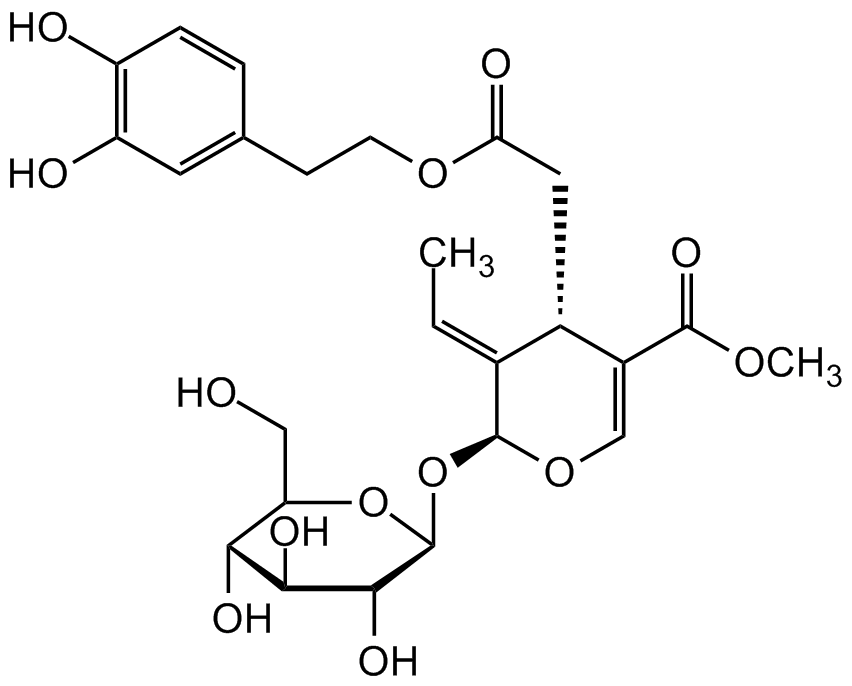Oleuropein
Product Code: AG-CN2-0538
Product Group: Natural Products and Extracts
Supplier: AdipoGen Life Sciences
| Code | Size | Price |
|---|
| AG-CN2-0538-M025 | 25 mg | £50.00 |
Quantity:
Prices exclude any Taxes / VAT
Overview
Host Type: Plant
Regulatory Status: RUO
Shipping:
AMBIENT
Storage:
Short Term: +4°C Long Term: -20°C
Images
Documents
Further Information
Alternate Names/Synonyms:
Oleoeuropein
Appearance:
White to off-white solid.
CAS:
32619-42-4
EClass:
32160000
Form (Short):
solid
Handling Advice:
Keep cool and dry.
InChi:
InChI=1S/C25H32O13/c1-3-13-14(9-19(29)35-7-6-12-4-5-16(27)17(28)8-12)15(23(33)34-2)11-36-24(13)38-25-22(32)21(31)20(30)18(10-26)37-25/h3-5,8,11,14,18,20-22,24-28,30-32H,6-7,9-10H2,1-2H3/b13-3+/t14-,18+,20+,21-,22+,24-,25-/m0/s1
InChiKey:
RFWGABANNQMHMZ-ZCHJGGQASA-N
Long Description:
Chemical. CAS: 32619-42-4. Formula: C25H32O13. MW: 540.5. Oleuropein is a polyphenol from olive leaves and fruits that hydrolyzes to form hydroxytyrosol and tyrosol. Oleuropein exhibits antioxidant, anti-inflammatory, anticancer, antimicrobial, antifungal, antiviral, antiobesity, antidiabetic, antihypertensive, hypolipidemic, hepatoprotective and neuroprotective properties. Free radical-scavenging compound. Inhibits cell proliferation, cell growth, migration, invasion and angiogenesis and induces apoptosis and cell cycle arrest in cancer cells but not normal cells. Modulates gene expression and activity of a variety of different signaling proteins that play a role in proliferation and apoptosis. Induces autophagy by activating AMPK. Potential agent against metabolic syndrome. Reduces adipogenesis by antagonizing PPARgamma. Enhances UCP1 expression in brown adipose tissue in high-fat-diet-induced obese rats by activating beta-adrenergic signaling. Promotes beta cell insulin secretion and protects beta cells from amylin amyloid-induced cytotoxicity. Improves insulin resistance by promoting GLUT4 translocation. Inhibits expression of inflammatory mediators by suppressing the activation of NF-kappaB and MAPKs. HIV-1 fusion and integrase inhibitor.
MDL:
MFCD16879008
Molecular Formula:
C25H32O13
Molecular Weight:
540.5
Package Type:
Vial
Product Description:
Oleuropein is a polyphenol from olive leaves and fruits that hydrolyzes to form hydroxytyrosol and tyrosol. Oleuropein exhibits antioxidant, anti-inflammatory, anticancer, antimicrobial, antifungal, antiviral, antiobesity, antidiabetic, antihypertensive, hypolipidemic, hepatoprotective and neuroprotective properties. Free radical-scavenging compound. Inhibits cell proliferation, cell growth, migration, invasion and angiogenesis and induces apoptosis and cell cycle arrest in cancer cells but not normal cells. Modulates gene expression and activity of a variety of different signaling proteins that play a role in proliferation and apoptosis. Induces autophagy by activating AMPK. Potential agent against metabolic syndrome. Reduces adipogenesis by antagonizing PPARgamma. Enhances UCP1 expression in brown adipose tissue in high-fat-diet-induced obese rats by activating beta-adrenergic signaling. Promotes beta cell insulin secretion and protects beta cells from amylin amyloid-induced cytotoxicity. Improves insulin resistance by promoting GLUT4 translocation. Inhibits expression of inflammatory mediators by suppressing the activation of NF-kappaB and MAPKs. HIV-1 fusion and integrase inhibitor.
Purity:
>98% (HPLC)
SMILES:
OC1=C(O)C=CC(CCOC(C[C@H]2/C([C@H](O[C@H]3[C@H](O)[C@@H](O)[C@H](O)[C@@H](CO)O3)OC=C2C(OC)=O)=CC)=O)=C1
Solubility Chemicals:
Soluble in DMSO (30mg/ml), ethanol (30mg/ml) or dimethylformamide (50mg/ml).
Source / Host:
Isolated from Olea europaea.
Transportation:
Non-hazardous
UNSPSC Category:
Natural Products/Extracts
UNSPSC Number:
12352200
Use & Stability:
Stable for at least 2 years after receipt when stored at -20°C.
References
Studies on the mechanism of the antimicrobial action of oleuropein: B. Juven, et al.; J. Appl. Bacteriol. 35, 559 (1972) | Scavenging of reactive oxygen species by the plant phenols genistein and oleuropein: I. Kruk, et al.; Luminescence 20, 81 (2005) | Oleuropein, a non-toxic olive iridoid, is an anti-tumor agent and cytoskeleton disruptor: H.K. Hamdi & R. Castellon; BBRC 334, 769 (2005) | Discovery of small-molecule HIV-1 fusion and integrase inhibitors oleuropein and hydroxytyrosol: Part I. fusion [corrected] inhibition: S. Lee-Huang, et al.; BBRC 354, 872 (2007) | Discovery of small-molecule HIV-1 fusion and integrase inhibitors oleuropein and hydroxytyrosol: part II. integrase inhibition: S. Lee-Huang, et al.; BBRC 354, 879 (2007) | Oleuropein in olive and its pharmacological effects: S.H. Omar; Sci. Pharm. 78, 133 (2010) (Review) | Oleuropein, an anti-oxidant polyphenol constituent of olive promotes alpha-secretase cleavage of the amyloid precursor protein (AbetaPP): M. Kostomoiri, et al.; Cell Mol. Neurobiol. 33, 147 (2013) | Oleuropein as an inhibitor of peroxisome proliferator-activated receptor gamma: M. Svobodova, et al.; Genes Nutr. 9, 376 (2014) | Antifungal Activity of Oleuropein against Candida albicans-The In Vitro Study: N. Zoric, et al.; Molecules 21, E1631 (2016) | Anticancer effects of oleuropein: H. Shamshoum, et al.; Biofactors 43, 517 (2017) (Review) | Oleuropein aglycone enhances UCP1 expression in brown adipose tissue in high-fat-diet-induced obese rats by activating beta-adrenergic signaling: Y. Oi-Kano, et al.; J. Nutr. Biochem. 40, 209 (2017) | Olive Component Oleuropein Promotes beta-Cell Insulin Secretion and Protects beta-Cells from Amylin Amyloid-Induced Cytotoxicity: L. Wu, et al.; Biochemistry 56, 5035 (2017) | Oleuropein inhibits the IL-1beta-induced expression of inflammatory mediators by suppressing the activation of NF-kappaB and MAPKs in human osteoarthritis chondrocytes: Z. Feng, et al.; Food Funct. 8, 3737 (2017) | Oleuropein improves insulin resistance in skeletal muscle by promoting the translocation of GLUT4: Y. Fujiwara, et al.; J. Clin. Biochem. Nutr. 61, 196 (2017) | Antitumor Perspectives of Oleuropein and Its Metabolite Hydroxytyrosol: Recent Updates: M. Imran, et al.; J. Food Sci. 83, 1781 (2018) (Review) | Oleuropein: A natural antioxidant molecule in the treatment of metabolic syndrome: J. Ahamad, et al.; Phytother. Res. 33, 3112 (2019) (Review)



